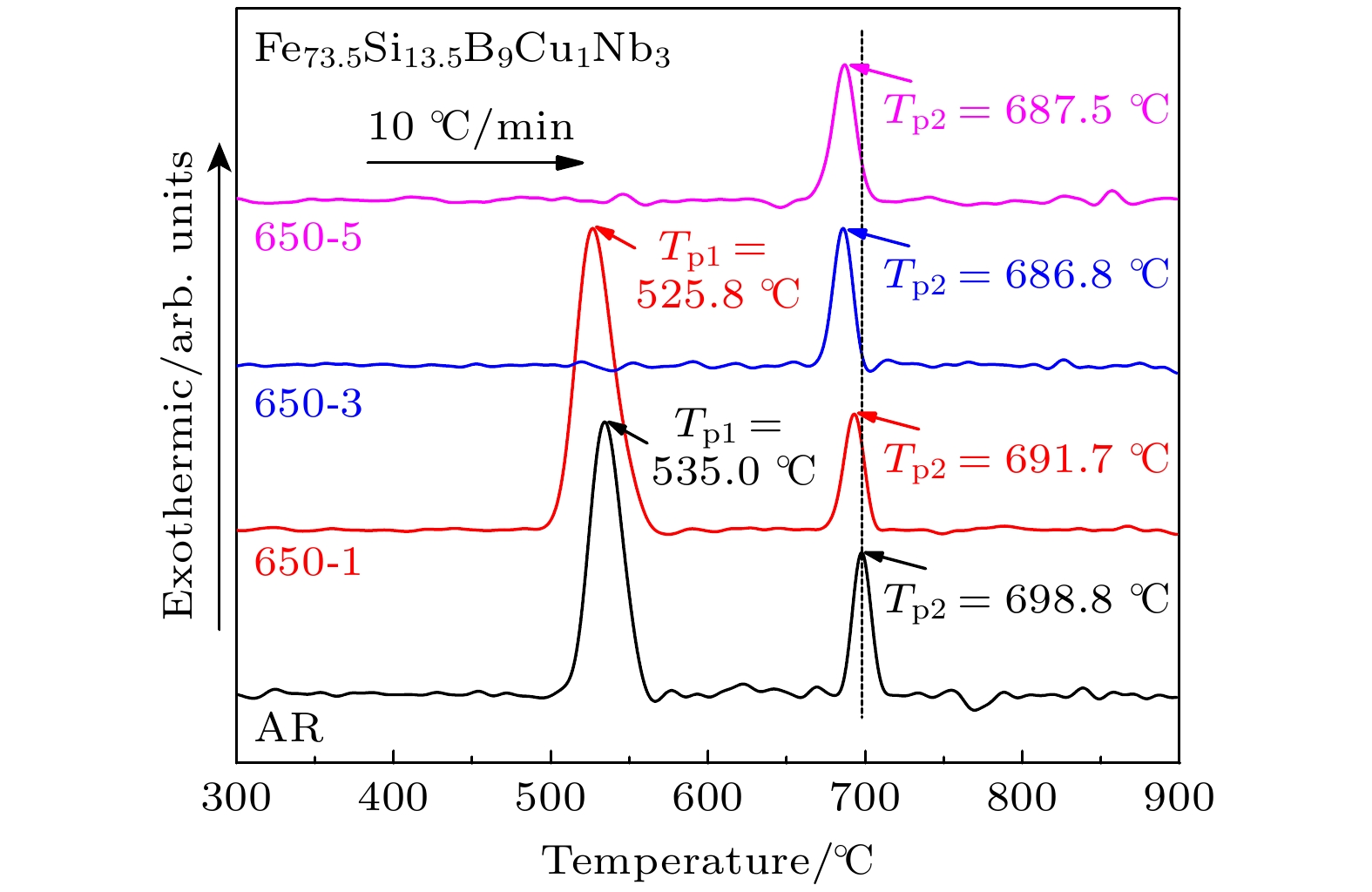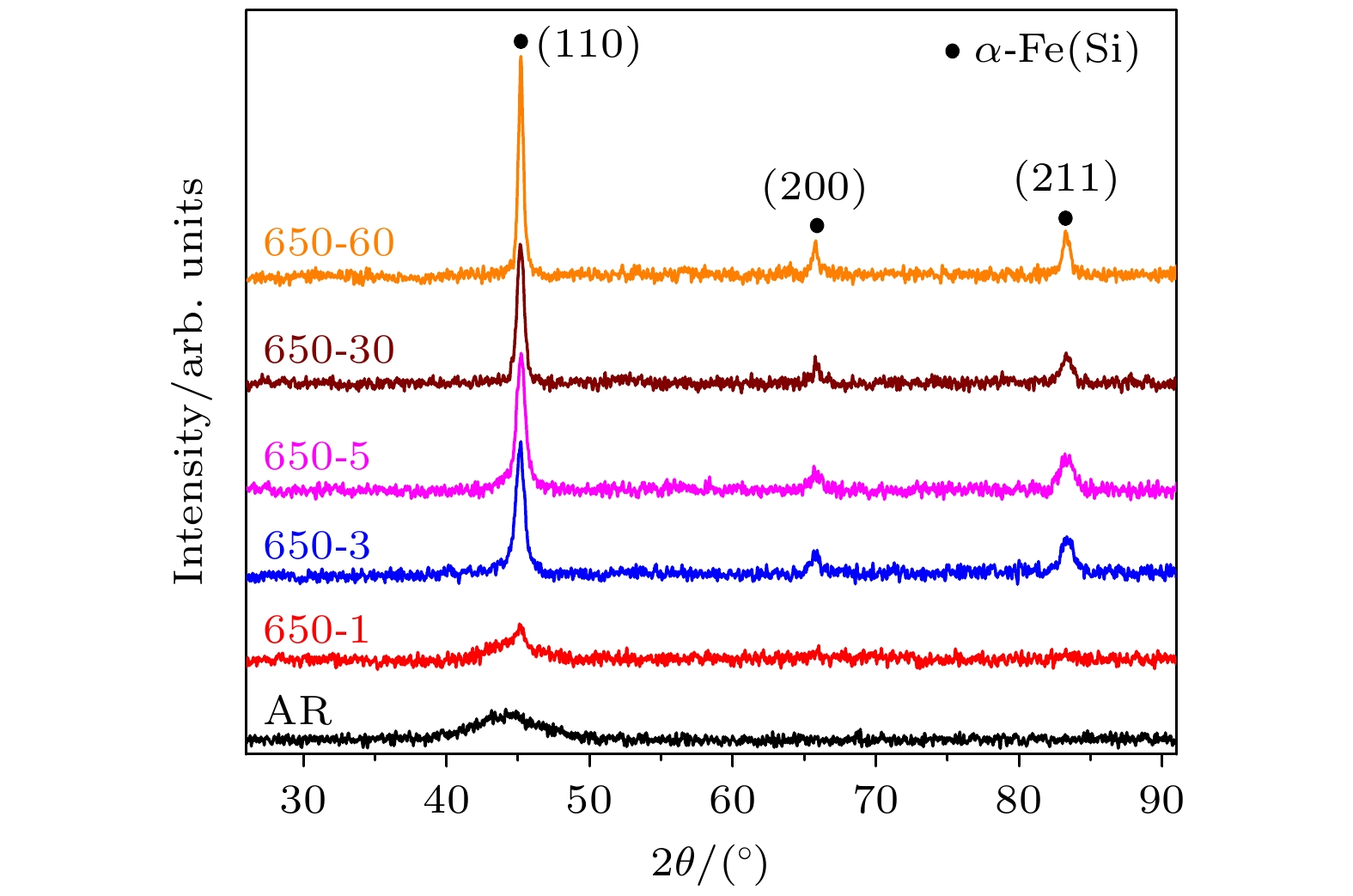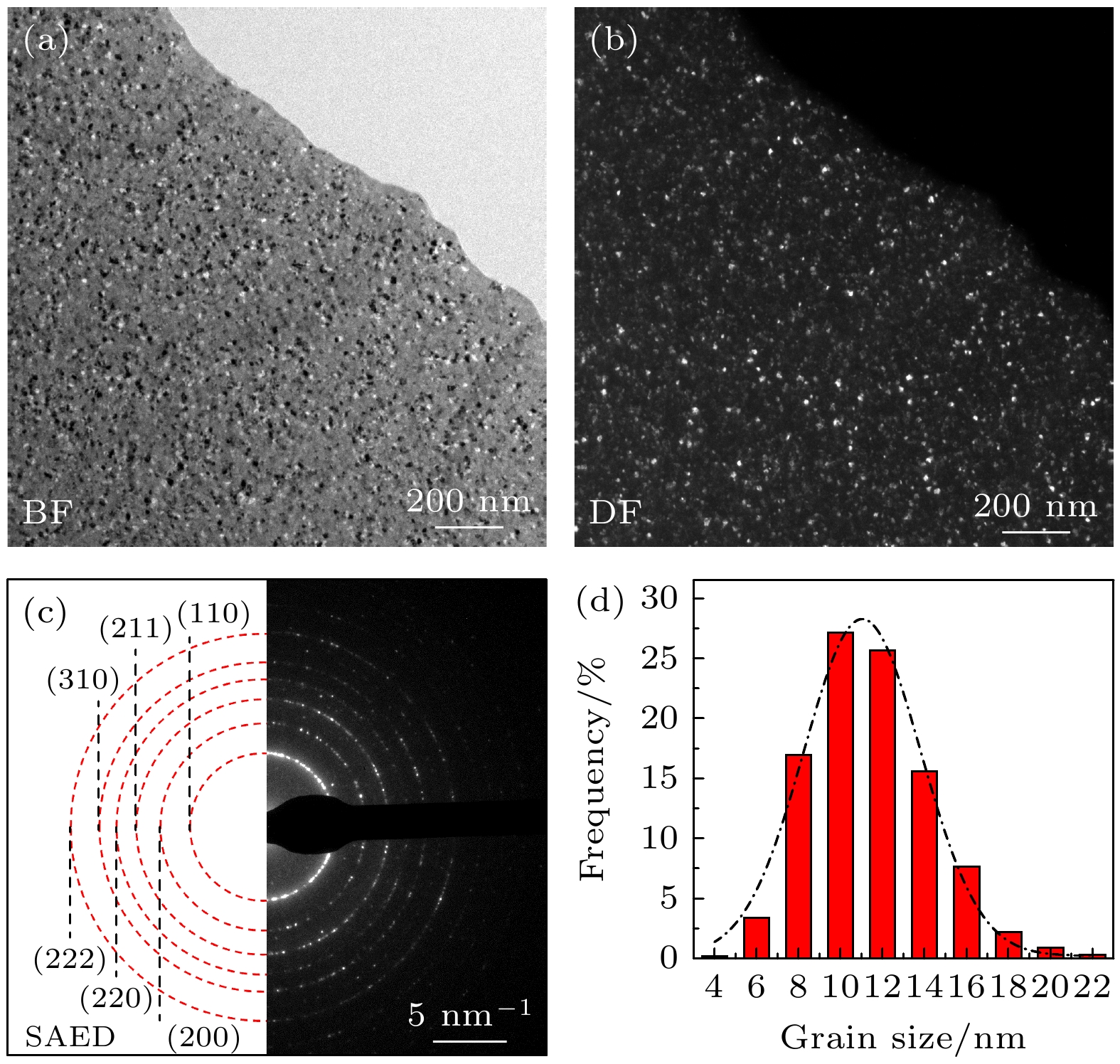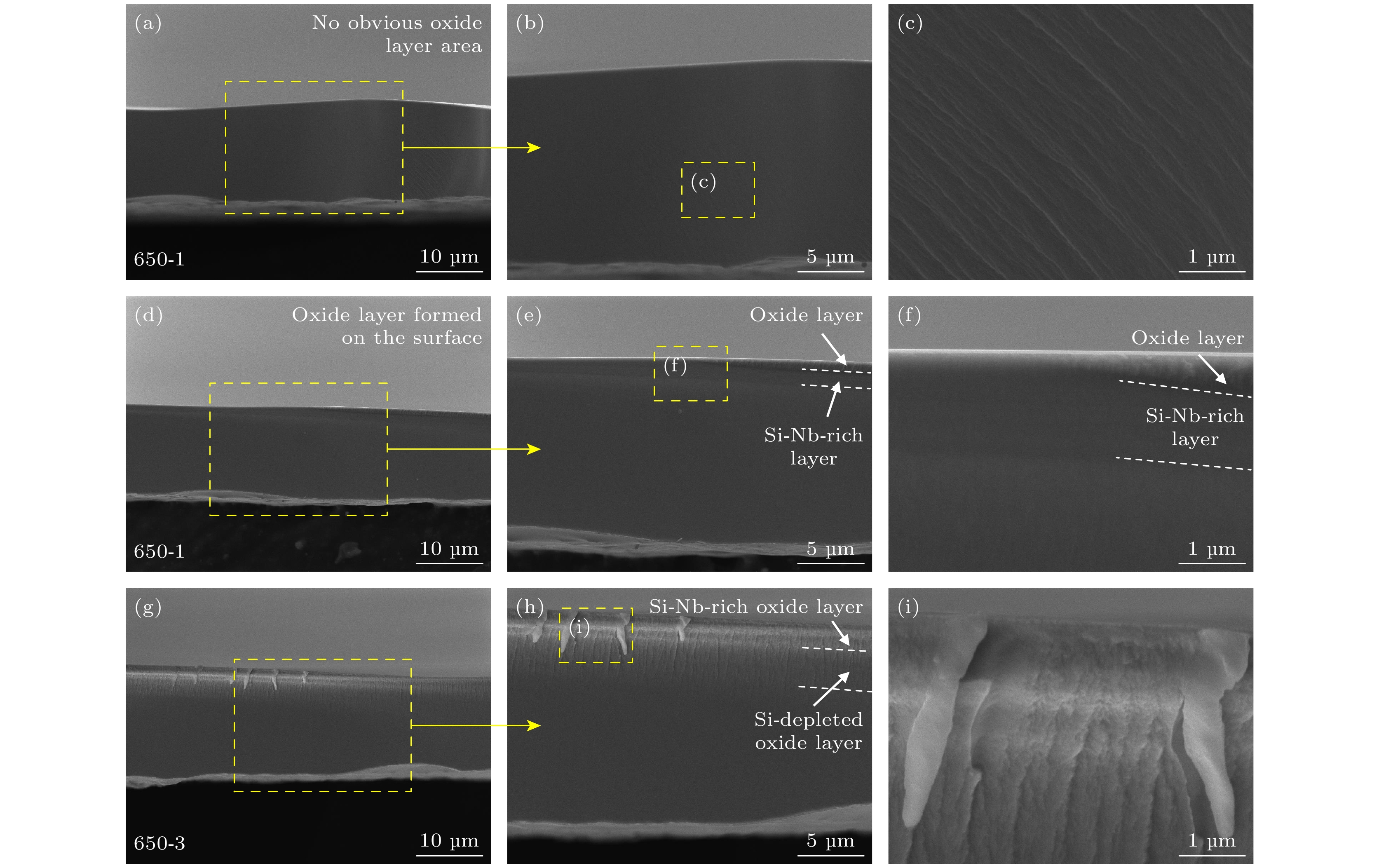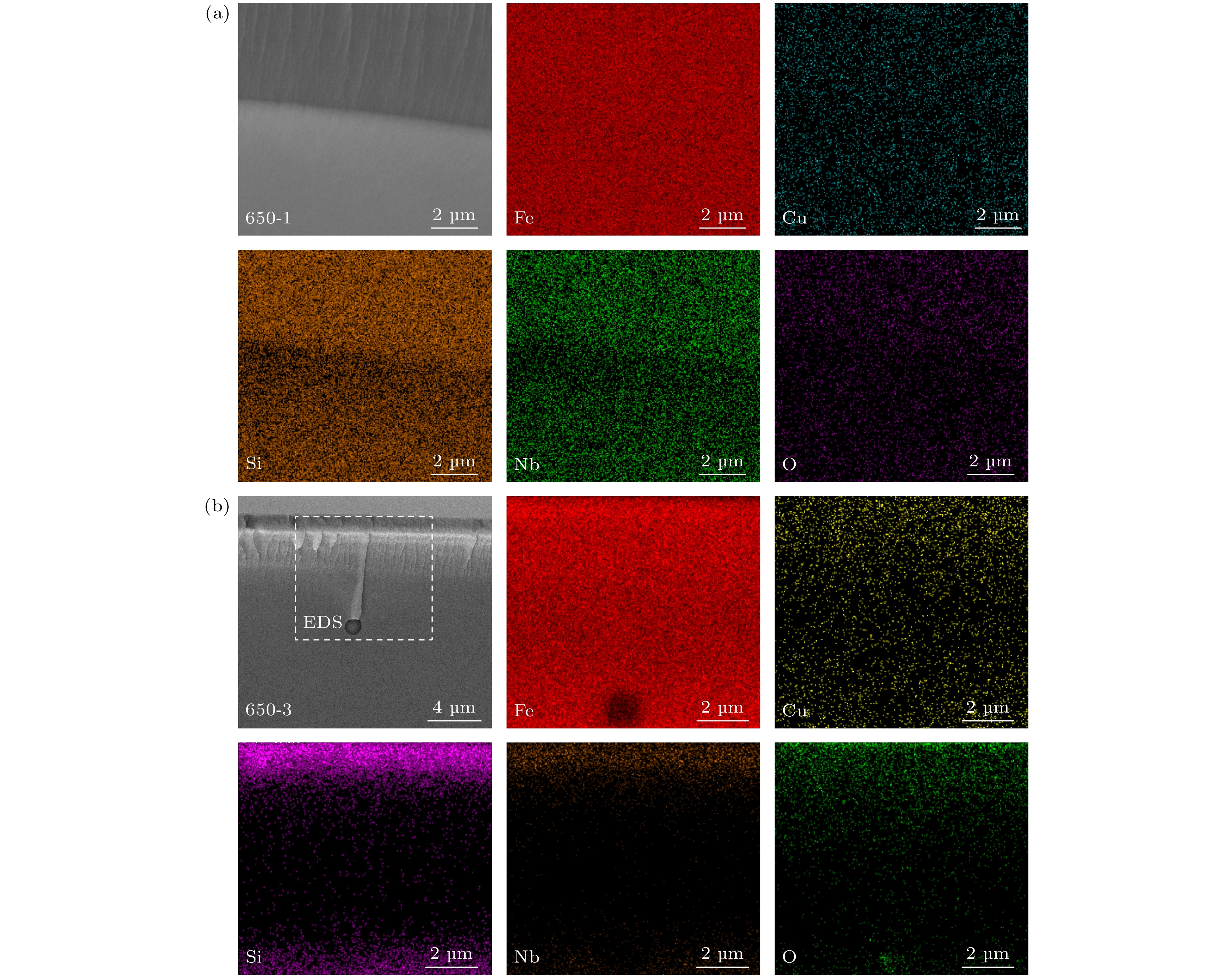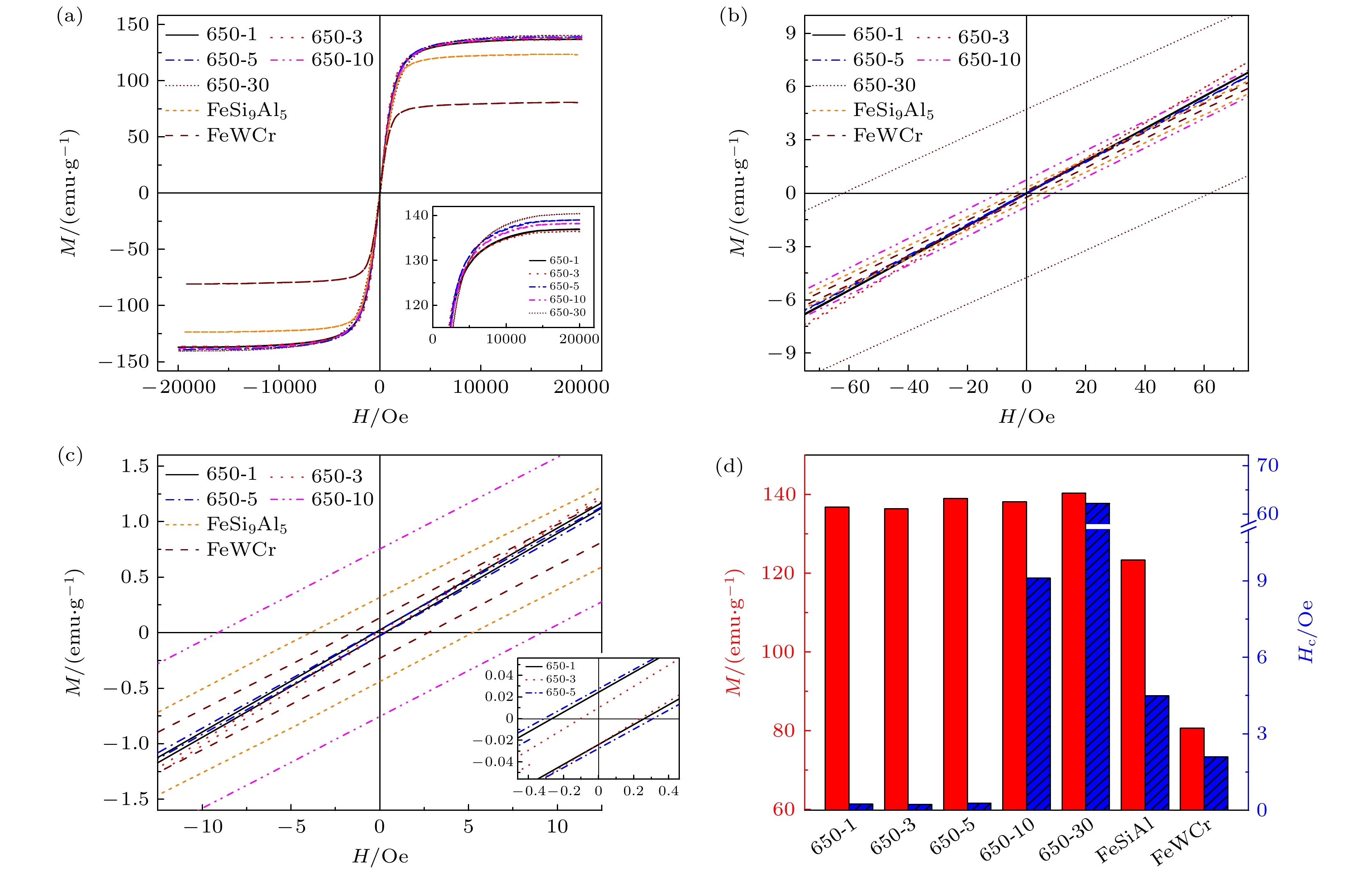-
Fe-based amorphous alloys are widely used in electronic devices such as high-frequency transformers and choke cores due to their low coercivity, low loss, and high saturation magnetic induction intensity. However, these alloys have a relatively low crystallization temperature and are prone to oxidation, which limits their applications in high-temperature environments. The addition of copper and niobium elements can suppress the growth of crystal nuclei and improve thermal stability. However, the influences on the alloy's high-temperature oxidation resistance and structural evolution are still unclear. In this work, static air oxidation is used to investigate the microstructure evolution of Fe73.5Si13.5B9Cu1Nb3 amorphous alloy after high-temperature oxidation and its influence on magnetic properties. Besides, long-time oxidation, say, 3000 hours or longer at 500 ℃, is generally hard to perform in the laboratory. Thus, the Van’t Hoff’s rule is used to evaluate outcomes under the condition of the long-time and relatively low-temperature oxidation through using rapid high-temperature oxidation. Based on Van’t Hoff’s rule, the oxidation at 650 ℃ for 5 min will show similar or more severe oxidation effects on the microstructure of Fe73.5Si13.5B9Cu1Nb3 alloy after oxidation at 500 ℃ for 2730 h. The microstructure evolution reveals that silicon and niobium in this alloy will quickly diffuse toward the sample surface during oxidation at 650 ℃, and these two elements will form a dense layer to impede oxygen diffusion. Meanwhile, an α-Fe(Si) phase, mainly composed of iron elements, will be generated in the alloy, with its grain size slowly increasing in the oxidation process. Thermodynamic analysis indicates that the segregation of silicon and niobium can preserve the thermodynamic stability of the alloy system during oxidation and suppress the formation of intermetallic compounds during crystallization. The magnetic hysteresis loop results show that the coercivity of Fe73.5Si13.5B9Cu1Nb3 alloy after 5-min oxidation at 650 ℃ will stay at approximately 0.3 Oe, suggesting that the Fe73.5Si13.5B9Cu1Nb3 alloy may be a candidate for operating at 500 ℃ for more than 2700 h. Subsequently, its coercivity gradually increases to 61 Oe as the oxidation time rises to 0.5 h, while its saturation magnetic induction intensity remains unchanged (~140 emu/g).
-
Keywords:
- Fe-based amorphous alloys /
- high-temperature oxidation /
- crystallization mechanism /
- magnetic properties
[1] Lang R Q, Chen H Y, Zhang J R, Li H P, Guo D F, Kou J Y, Zhao J, Fang Y K, Wang X Q, Qi X W, Wang Y D, Ren Y, Wang H Z 2024 Adv. Sci. 11 2402162
 Google Scholar
Google Scholar
[2] Panda A K, Mohanta O, Mitra A, Jiles D C, Lo C C H, Melikhov Y 2007 J. Magn. Magn. Mater. 316 e886
 Google Scholar
Google Scholar
[3] 董哲, 陈国钧, 彭伟锋, 高温应用软磁材料 2005 金属功能材料 12 35
 Google Scholar
Google Scholar
Dong Z, Chen G J, Peng W F 2005 Met. Funct. Mater. 12 35
 Google Scholar
Google Scholar
[4] 熊政伟, 杨江, 王雨, 杨陆, 管弦, 曹林洪, 王进, 高志鹏 2022 71 157502
 Google Scholar
Google Scholar
Xiong Z W, Yang J, Wang Y, Yang L, Guan X, Cao L H, Wang J, Gao Z P 2022 Acta Phys. Sin. 71 157502
 Google Scholar
Google Scholar
[5] Silveyra J M, Ferrara E, Huber D L, Monson T C 2018 Science 362 80
 Google Scholar
Google Scholar
[6] Zhang R, Zhou C, Chen K Y, Cao K Y, Zhang Y, Tian F H, Murtaza A, Yang S, Song X P 2021 Scr. Mater. 203 114043
 Google Scholar
Google Scholar
[7] Santhosh Kumar R, Rashmi, Sundara Rajan J 2022 IEEE International Conference on Nanoelectronics, Nanophotonics, Nanomaterials, Nanobioscience & Nanotechnology (5NANO) Kottayam, India, April 28–29, 2022 p1
[8] Knipling K E, Daniil M, Willard M A 2009 Appl. Phys. Lett. 95 2
 Google Scholar
Google Scholar
[9] Luo Z G, Fan X A, Zhang Y L, Yang Z J, Wang J, Wu Z Y, Liu X, Li G Q, Li Y W 2021 J. Alloy. Compd. 862 158595
 Google Scholar
Google Scholar
[10] Du T, Varaprasad B S D C S, Guo Z, Gellman A J, Zhu J G, Laughlin D E 2021 J. Magn. Magn. Mater. 539 168347
 Google Scholar
Google Scholar
[11] Wu L C, Li Y H, He A N, Zhu Z W, Zhang H F, Zhang W 2023 Intermetallics 163 108040
 Google Scholar
Google Scholar
[12] Yu R H, Basu S, Ren L, Zhang Y, Parvizi-Majidi A, Unruh K M, Xiao J Q 2000 IEEE Tran. Magn. 36 3388
 Google Scholar
Google Scholar
[13] Corodeanu S, Hlenschi C, Chiriac H, Óvári T A, Lupu N 2023 IEEE International Magnetic Conference Sendai, Japan, May 15–19, 2023
[14] Zhou J, Li X S, Hou X B, Ke H B, Fan X D, Luan J H, Peng H L, Zeng Q S, Lou H B, Wang J G, Liu C T, Shen B L, Sun B A, Wang W H, Bai H Y 2023 Adv. Mater. 35 2304490
 Google Scholar
Google Scholar
[15] Ma Y, Wang Q, Zhou X Y, Hao J M, Gault B, Zhang Q Y, Dong C, Nieh T G 2021 Adv. Mater. 33 2006723
 Google Scholar
Google Scholar
[16] Shi R M, Wang Z, Han Y M 2019 AIP Adv. 9 055222
 Google Scholar
Google Scholar
[17] Fu P X, Shi J L, Shi R C, Zhang Y Y, Qi J T, Yang Y Z 2023 Mater. Today Commun. 36 106685
 Google Scholar
Google Scholar
[18] Wu Y, Dai Z K, Liu R R, Zhou H T 2024 J. Alloy. Compd. 981 173713
 Google Scholar
Google Scholar
[19] Zhang Y K, Zhu J, Li S, Wang J, Ren Z M 2022 J. Mater. Sci. Technol. 102 66
 Google Scholar
Google Scholar
[20] Kowalczyk M, Ferenc J, Liang X B, Kulik T 2006 J. Magn. Magn. Mater. 304 e651
 Google Scholar
Google Scholar
[21] Han L L, Maccari F, Soldatov I, Peter N J, Souza Filho I R, Schafer R, Gutfleisch O, Li Z M, Raabe D 2023 Nat. Commun. 14 8176
 Google Scholar
Google Scholar
[22] Wang Y F, Xu J, Liu Y J, Liu Z W 2022 Mater. Charact. 187 111830
 Google Scholar
Google Scholar
[23] Silveyra J M, Illeková E 2014 J. Alloy. Compd. 610 180
 Google Scholar
Google Scholar
[24] Shivaee H A, Golikand A N, Hosseini H R M, Asgari M 2010 J. Mater. Sci. 45 546
 Google Scholar
Google Scholar
[25] García J A, Pierna A R, Elbaile L, Crespo R D, Vara G, Marzo F F, Tejedor M 2006 J. Non-Cryst. Solids 352 5118
 Google Scholar
Google Scholar
[26] Zhu Z H, Yin L, Hu Q, Song H 2014 Rare Metal Mat. Eng. 43 1037
 Google Scholar
Google Scholar
[27] Blázquez J S, Conde C F, Conde A, Roth S, Güth A 2006 J. Magn. Magn. Mater. 304 627
 Google Scholar
Google Scholar
[28] May J E, Oliveira M F, Kuri S E 2003 Mater. Sci. Eng. A 361 179
 Google Scholar
Google Scholar
[29] Stuart F A F C 1912 Huygens Institute-Royal Netherlands Academy of Arts and Sciences (KNAW) Amsterdam, Netherlands, March 30, 1912 p1159
[30] 余秀冬, 刘海顺, 薛琳, 张响, 杨卫明 2024 73 98801
 Google Scholar
Google Scholar
Yu X D, Liu H S, Xue L, Zhang X, Yang W M 2024 Acta Phys. Sin. 73 98801
 Google Scholar
Google Scholar
[31] Liu H S, Du Y W, Miao X X, Han K, Shen X P, Bu W K 2008 Rare Metals 27 545
 Google Scholar
Google Scholar
[32] Luo T, Liu H L, Huang C M, Yue G, Hou F T, Yang Y Z 2023 J Mater. Sci. Mater. Electron. 34 2167
 Google Scholar
Google Scholar
[33] Jonghee H, Seoyeon K, Sungwoo S, Jan S, Haein C Y 2020 Metals 10 1297
 Google Scholar
Google Scholar
[34] 郭琦, 邓志旺, 朱乾科, 陈峰华, 胡勇, 张克维 2020 铸造技术 41 1005
Guo Q, Deng Z W, Zhu Q K, Chen F H, Hu Y, Zhang K W 2020 Foundry Technology 41 1005
[35] 张哲峰, 屈瑞涛, 刘增乾 2016 金属学报 52 1171
 Google Scholar
Google Scholar
Zhang Z F, Qu R T, Liu Z Q 2016 Acta Metall. Sin. 52 1171
 Google Scholar
Google Scholar
[36] Lu L, Du P C, Jiang T X, Zhou T C, Wen Q B, Wang Y L, Zeng Y, Xiong X 2025 J. Eur. Ceram. Soc. 45 116885
 Google Scholar
Google Scholar
[37] Sun Y, Li J W, Xie L, He A N, Dong Y Q, Liu Y X, Wang C J, Zhang K W 2021 J. Non-Cryst. Solids 566 120839
 Google Scholar
Google Scholar
-
图 4 经过650 ℃氧化3 min后Fe73.5Si13.5B9Cu1Nb3非晶条带内部纳米晶的TEM表征 (a) 明场像; (b) 暗场像; (c) 选区电子衍射花样; (d) 晶粒尺寸分布图
Figure 4. The TEM characterization of newly formed nanograins in the amorphous ribbon after oxidation at 650℃ for 3 min: (a) Bright-field image; (b) dark-field image; (c) selected area electron diffraction pattern; (d) grain size distribution.
图 6 经过650 ℃氧化后Fe73.5Si13.5B9Cu1Nb3非晶条带断面的二次电子显微图像 (a)—(c) 氧化1 min后未形成氧化层; (d)—(f) 氧化1 min后已形成氧化层; (g)—(i) 氧化3 min后的典型断面
Figure 6. SEM images of the fracture surface of Fe73.5Si13.5B9Cu1Nb3 amorphous ribbons after oxidation at 650℃: (a)–(c) 1 min, showing no obvious oxide layer, (d)–(f) 1 min, exhibiting oxide layer, and (g)–(i) 3 min.
表 1 650 ℃高温氧化不同时间后非晶条带析出纳米晶晶粒尺寸计算结果
Table 1. The calculated grain size of newly formed nanograins in Fe73.5Si13.5B9Cu1Nb3 amorphous ribbons after oxidation at 650 ℃ for different times.
Sample
No.Oxidation time
at 650 ℃/minFWHM/(°) 2θ/(°) Dhkl/nm 650-1 1 0.960 44.7696 9.35 650-3 3 0.647 45.1310 13.89 650-5 5 0.564 45.1976 15.94 650-30 30 0.464 45.1826 19.37 650-60 60 0.415 45.1820 21.66 -
[1] Lang R Q, Chen H Y, Zhang J R, Li H P, Guo D F, Kou J Y, Zhao J, Fang Y K, Wang X Q, Qi X W, Wang Y D, Ren Y, Wang H Z 2024 Adv. Sci. 11 2402162
 Google Scholar
Google Scholar
[2] Panda A K, Mohanta O, Mitra A, Jiles D C, Lo C C H, Melikhov Y 2007 J. Magn. Magn. Mater. 316 e886
 Google Scholar
Google Scholar
[3] 董哲, 陈国钧, 彭伟锋, 高温应用软磁材料 2005 金属功能材料 12 35
 Google Scholar
Google Scholar
Dong Z, Chen G J, Peng W F 2005 Met. Funct. Mater. 12 35
 Google Scholar
Google Scholar
[4] 熊政伟, 杨江, 王雨, 杨陆, 管弦, 曹林洪, 王进, 高志鹏 2022 71 157502
 Google Scholar
Google Scholar
Xiong Z W, Yang J, Wang Y, Yang L, Guan X, Cao L H, Wang J, Gao Z P 2022 Acta Phys. Sin. 71 157502
 Google Scholar
Google Scholar
[5] Silveyra J M, Ferrara E, Huber D L, Monson T C 2018 Science 362 80
 Google Scholar
Google Scholar
[6] Zhang R, Zhou C, Chen K Y, Cao K Y, Zhang Y, Tian F H, Murtaza A, Yang S, Song X P 2021 Scr. Mater. 203 114043
 Google Scholar
Google Scholar
[7] Santhosh Kumar R, Rashmi, Sundara Rajan J 2022 IEEE International Conference on Nanoelectronics, Nanophotonics, Nanomaterials, Nanobioscience & Nanotechnology (5NANO) Kottayam, India, April 28–29, 2022 p1
[8] Knipling K E, Daniil M, Willard M A 2009 Appl. Phys. Lett. 95 2
 Google Scholar
Google Scholar
[9] Luo Z G, Fan X A, Zhang Y L, Yang Z J, Wang J, Wu Z Y, Liu X, Li G Q, Li Y W 2021 J. Alloy. Compd. 862 158595
 Google Scholar
Google Scholar
[10] Du T, Varaprasad B S D C S, Guo Z, Gellman A J, Zhu J G, Laughlin D E 2021 J. Magn. Magn. Mater. 539 168347
 Google Scholar
Google Scholar
[11] Wu L C, Li Y H, He A N, Zhu Z W, Zhang H F, Zhang W 2023 Intermetallics 163 108040
 Google Scholar
Google Scholar
[12] Yu R H, Basu S, Ren L, Zhang Y, Parvizi-Majidi A, Unruh K M, Xiao J Q 2000 IEEE Tran. Magn. 36 3388
 Google Scholar
Google Scholar
[13] Corodeanu S, Hlenschi C, Chiriac H, Óvári T A, Lupu N 2023 IEEE International Magnetic Conference Sendai, Japan, May 15–19, 2023
[14] Zhou J, Li X S, Hou X B, Ke H B, Fan X D, Luan J H, Peng H L, Zeng Q S, Lou H B, Wang J G, Liu C T, Shen B L, Sun B A, Wang W H, Bai H Y 2023 Adv. Mater. 35 2304490
 Google Scholar
Google Scholar
[15] Ma Y, Wang Q, Zhou X Y, Hao J M, Gault B, Zhang Q Y, Dong C, Nieh T G 2021 Adv. Mater. 33 2006723
 Google Scholar
Google Scholar
[16] Shi R M, Wang Z, Han Y M 2019 AIP Adv. 9 055222
 Google Scholar
Google Scholar
[17] Fu P X, Shi J L, Shi R C, Zhang Y Y, Qi J T, Yang Y Z 2023 Mater. Today Commun. 36 106685
 Google Scholar
Google Scholar
[18] Wu Y, Dai Z K, Liu R R, Zhou H T 2024 J. Alloy. Compd. 981 173713
 Google Scholar
Google Scholar
[19] Zhang Y K, Zhu J, Li S, Wang J, Ren Z M 2022 J. Mater. Sci. Technol. 102 66
 Google Scholar
Google Scholar
[20] Kowalczyk M, Ferenc J, Liang X B, Kulik T 2006 J. Magn. Magn. Mater. 304 e651
 Google Scholar
Google Scholar
[21] Han L L, Maccari F, Soldatov I, Peter N J, Souza Filho I R, Schafer R, Gutfleisch O, Li Z M, Raabe D 2023 Nat. Commun. 14 8176
 Google Scholar
Google Scholar
[22] Wang Y F, Xu J, Liu Y J, Liu Z W 2022 Mater. Charact. 187 111830
 Google Scholar
Google Scholar
[23] Silveyra J M, Illeková E 2014 J. Alloy. Compd. 610 180
 Google Scholar
Google Scholar
[24] Shivaee H A, Golikand A N, Hosseini H R M, Asgari M 2010 J. Mater. Sci. 45 546
 Google Scholar
Google Scholar
[25] García J A, Pierna A R, Elbaile L, Crespo R D, Vara G, Marzo F F, Tejedor M 2006 J. Non-Cryst. Solids 352 5118
 Google Scholar
Google Scholar
[26] Zhu Z H, Yin L, Hu Q, Song H 2014 Rare Metal Mat. Eng. 43 1037
 Google Scholar
Google Scholar
[27] Blázquez J S, Conde C F, Conde A, Roth S, Güth A 2006 J. Magn. Magn. Mater. 304 627
 Google Scholar
Google Scholar
[28] May J E, Oliveira M F, Kuri S E 2003 Mater. Sci. Eng. A 361 179
 Google Scholar
Google Scholar
[29] Stuart F A F C 1912 Huygens Institute-Royal Netherlands Academy of Arts and Sciences (KNAW) Amsterdam, Netherlands, March 30, 1912 p1159
[30] 余秀冬, 刘海顺, 薛琳, 张响, 杨卫明 2024 73 98801
 Google Scholar
Google Scholar
Yu X D, Liu H S, Xue L, Zhang X, Yang W M 2024 Acta Phys. Sin. 73 98801
 Google Scholar
Google Scholar
[31] Liu H S, Du Y W, Miao X X, Han K, Shen X P, Bu W K 2008 Rare Metals 27 545
 Google Scholar
Google Scholar
[32] Luo T, Liu H L, Huang C M, Yue G, Hou F T, Yang Y Z 2023 J Mater. Sci. Mater. Electron. 34 2167
 Google Scholar
Google Scholar
[33] Jonghee H, Seoyeon K, Sungwoo S, Jan S, Haein C Y 2020 Metals 10 1297
 Google Scholar
Google Scholar
[34] 郭琦, 邓志旺, 朱乾科, 陈峰华, 胡勇, 张克维 2020 铸造技术 41 1005
Guo Q, Deng Z W, Zhu Q K, Chen F H, Hu Y, Zhang K W 2020 Foundry Technology 41 1005
[35] 张哲峰, 屈瑞涛, 刘增乾 2016 金属学报 52 1171
 Google Scholar
Google Scholar
Zhang Z F, Qu R T, Liu Z Q 2016 Acta Metall. Sin. 52 1171
 Google Scholar
Google Scholar
[36] Lu L, Du P C, Jiang T X, Zhou T C, Wen Q B, Wang Y L, Zeng Y, Xiong X 2025 J. Eur. Ceram. Soc. 45 116885
 Google Scholar
Google Scholar
[37] Sun Y, Li J W, Xie L, He A N, Dong Y Q, Liu Y X, Wang C J, Zhang K W 2021 J. Non-Cryst. Solids 566 120839
 Google Scholar
Google Scholar
Catalog
Metrics
- Abstract views: 3260
- PDF Downloads: 90
- Cited By: 0














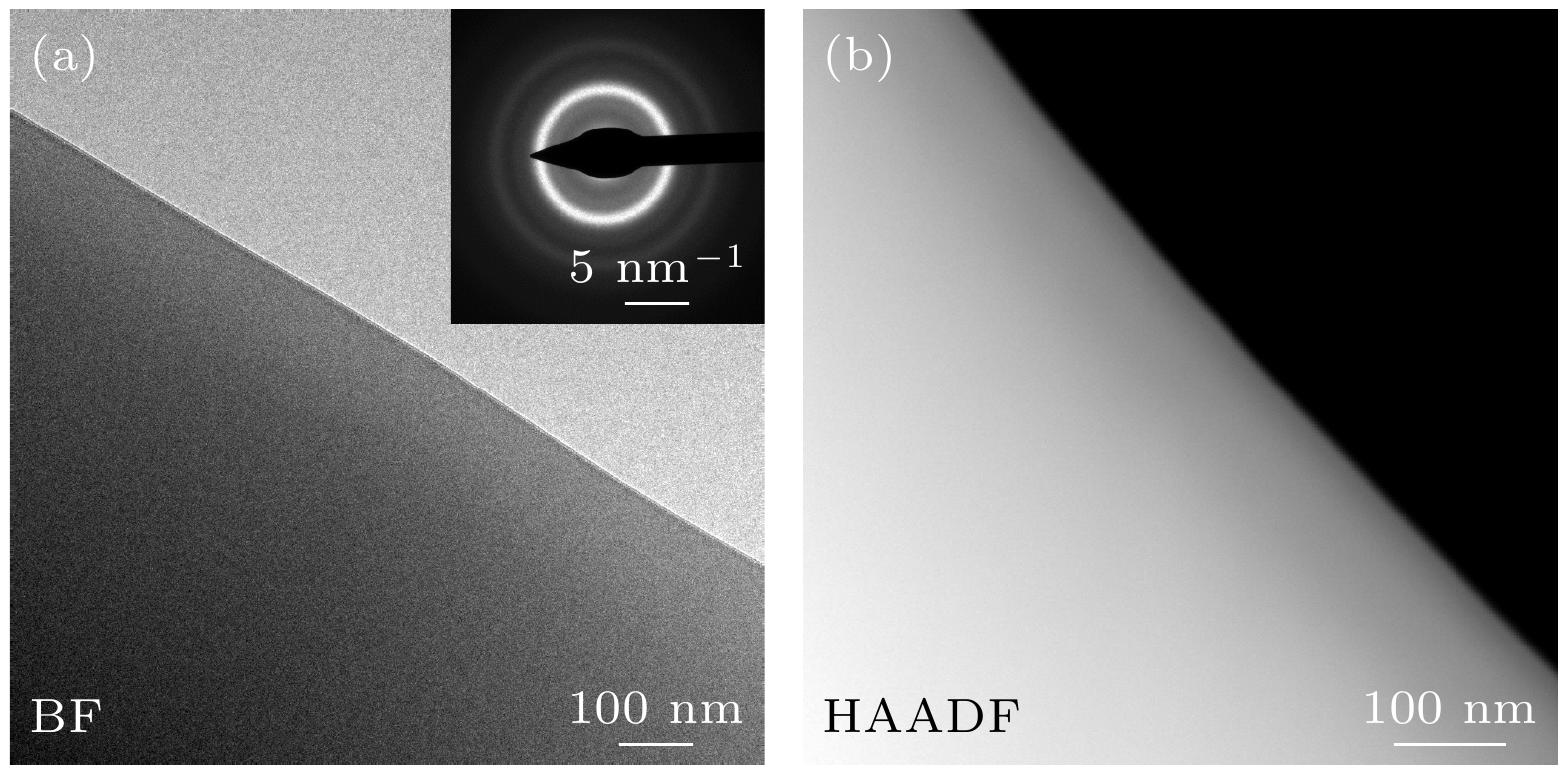
 DownLoad:
DownLoad:
